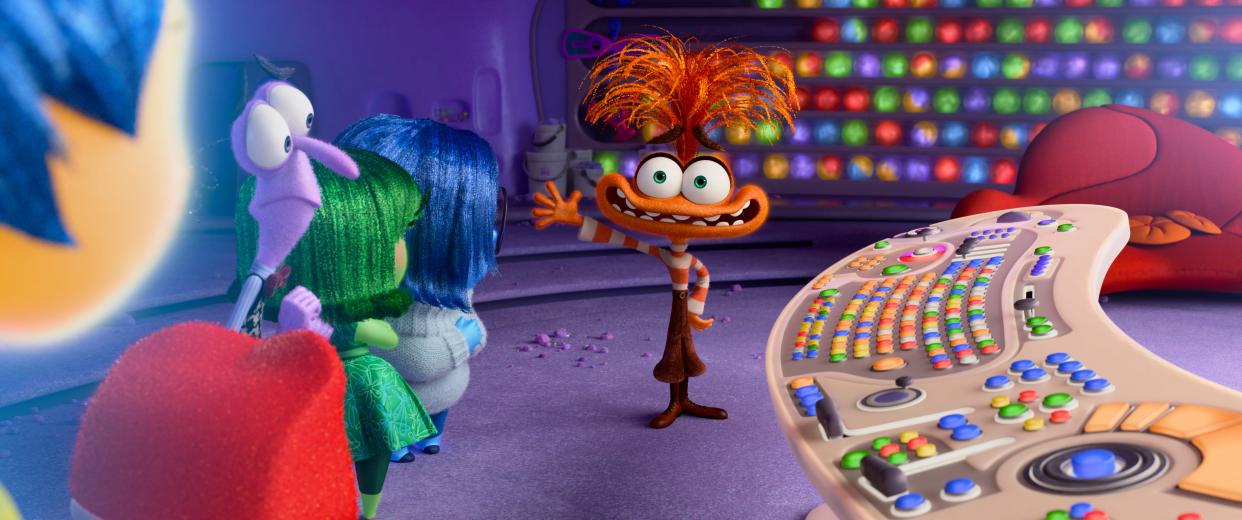How ‘Inside Out 2’ Is Helping Adults Better Understand Their Anxiety

Pixar
As an adult, Barb Baker, of Detroit, didn’t have particularly high expectations for Pixar’s new movie, Inside Out 2. But the animated film’s portrayal of anxiety really hit her “like a ton of bricks,” Baker tells SELF: “I’ve let anxiety steer the wheel of my life.”
Baker’s father died when she was a kid, and sitting in the theater, she realized she hadn’t fully moved on. “I was still a six-year-old mourning his passing, void of joy, and pretending to show others how ‘strong’ I was,” she says. “That realization became an eye-opening and healing moment for me.”
She posted her reaction to the movie on TikTok and was surprised that so many other people related to her feelings of grief and anxiety. “I’m blown away and choked up,” she says. “It may be for kids, but adults can really get something out of it.” Other videos show adults sobbing at the movie theater with no kids in sight, bonding over their newfound understanding of the roles that different emotions like anxiety and joy play in their lives.
The sequel to 2015’s Inside Out, which follows up with main character Riley as she navigates the wildly spinning of emotions that can happen at age 13, may help untangle some feelings that have traditionally been too taboo to talk about publicly, says Kristen Gingrich LCSW, CADC, a clinical social worker. We see characters from the original Inside Out, including Joy, Sadness, Fear, and Anger, but new characters make their debut, like Envy, Embarrassment, Ennui—and the emerging star of the quirky bunch, Anxiety. Thanks to Anxiety, Riley starts having a panic attack mid-hockey game and tells herself she’s not good enough. “We were all teenagers once,” Gingrich tells SELF. “A lot of the adults who are relating to this now are starting to put those pieces of the puzzle together because this stuff—anxiety—wasn’t talked about back then like it is now.”
“It’s so gratifying to see adults talking about their experiences with their own anxiety and sense of self,” Meg LeFauve, cowriter of Inside Out 2, tells SELF. “It’s always the intention when you're doing a story to speak your authentic truth to the audience so that they can receive it and have that catharsis with you. I couldn’t in my wildest dreams imagine this…. It feels a little bit like winning the lottery.”
Francis Dominic, 31, of New York, says Inside Out 2 left him and his friends in tears. He felt like the movie “held a mirror” in front of people who deal with anxiety. “The whirlwind that Anxiety causes in herself is so real. We’ve all spiraled in some way like that before,” he says. “It showed us that even if anxiety is a part of us, it doesn’t define us, and we can learn to love all aspects of ourselves.”
Anxiety does serve a purpose, Gingrish says. “It keeps us safe, but it also helps us develop our sense of self,” she says. “The issue with anxiety is that when it starts to drive the bus; it drives our decisions based on what-ifs—and sometimes we don’t even realize our anxiety gets to a place like that.”
For 14-year-old Viviana Garcia, Inside Out 2 confirmed what she already knew about anxiety—that it can give you panic attacks and generally cause you to, as she puts it, “freak out.” But she did learn something new: Anxiety can be good for you too. As an eighth grader in her first year on a varsity soccer team, Garcia related to Riley’s nervousness about competing with older, more experienced players on her hockey team, as well as her determination to get better (which Anxiety drives her to do). “It was really good to see that anxiety can actually encourage you to get up off your feet and do something to improve your performance for something you’re passionate about.”
More than anything, though, the movie reminded Garcia that she’s not the only person (or teen!) who’s dealing with a bunch of confusing emotions. “I thought it was just going to be some funny little kid movie, but after realizing Riley was about my age, I related to her in a way I’ve never felt in a movie before,” Garcia tells SELF. “It was just so real, how all of your emotions can be a lot louder than how you intend for them to come out, especially during puberty…. You kind of just have to balance them out.”
That’s the beauty of children’s movies, Gingrich says: “Sometimes we gotta take it back to the basics. This movie truly encapsulates that each emotion serves a purpose in our lives. The good, the bad, and the ugly. It’s just knowing where it’s appropriate and when it’s becoming too much—and remembering that sometimes, you just have to look for joy to experience it.”
Related:
‘Inside Out 2’ Writer Meg LeFauve Shares How Her Own Anxiety Helped Inspire the Movie
How to Calm Your Nerves When You’re Freaking Out, According to Experts
5 Deep Breathing Exercises to Try When You Really Need a Minute
Get more of SELF's great service journalism delivered right to your inbox—for free.
Originally Appeared on SELF


